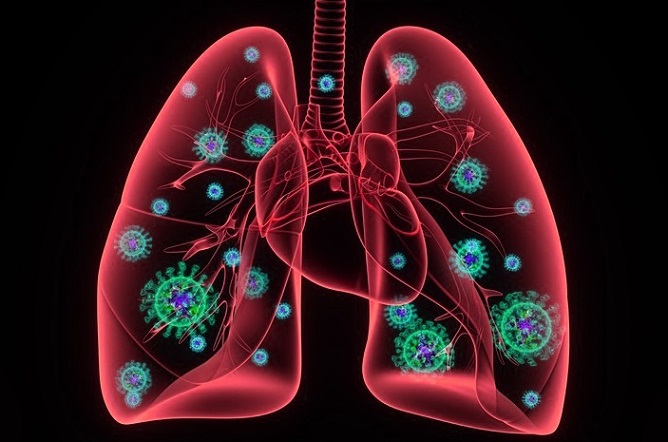Indian Study Unveils Protein Changes in Lung Cells in Response to SARS-CoV-2 ORF3a
Nikhil Prasad Fact checked by:Thailand Medical News Team Jan 18, 2025 11 months, 1 day, 8 hours, 27 minutes ago
Medical News: Researchers from prominent Indian institutions, including Banaras Hindu University’s Institute of Medical Sciences, the Dr. B.R. Ambedkar Center for Biomedical Research, and the Delhi School of Public Health at the University of Delhi, have uncovered significant insights into how SARS-CoV-2, the virus responsible for COVID-19, manipulates the protein landscape of human lung cells. This
Medical News report highlights findings that deepen our understanding of the virus and may pave the way for new treatments.
 Indian Study Unveils Protein Changes in Lung Cells in Response to SARS-CoV-2 ORF3a
Indian Study Unveils Protein Changes in Lung Cells in Response to SARS-CoV-2 ORF3a
The study, led by Professor Sunit K. Singh, focuses on ORF3a, one of the nine accessory proteins of SARS-CoV-2. This protein has long been suspected of playing a key role in the virus’s ability to evade the immune system and promote its replication. By conducting a detailed proteomic analysis, the researchers have mapped how ORF3a affects the proteins in human lung epithelial cells, revealing pathways that the virus exploits.
Understanding ORF3a and Its Functions
ORF3a is the largest accessory protein in SARS-CoV-2, with a molecular weight of 31 kDa. Earlier studies have linked ORF3a to immune evasion, inflammasome activation, and cell death mechanisms such as apoptosis, pyroptosis, and necrosis. While the protein does not directly aid viral replication, it has significant indirect effects, such as inhibiting type I interferon responses and promoting pro-inflammatory cytokine production through pathways like NF-κB and TLR3/4 signaling.
The researchers’ focus on ORF3a stemmed from its ability to disrupt cellular processes, including autophagy - a mechanism cells use to clear out damaged components. ORF3a blocks the fusion of autophagosomes with lysosomes, impairing the cell’s ability to degrade viral components. This strategy allows SARS-CoV-2 to evade destruction and enhance its survival.
Key Findings from Proteomic Analysis
Using high-resolution mass spectrometry, the researchers compared the protein expression profiles of human lung epithelial cells transfected with ORF3a to those of untransfected control cells. They identified 56 differentially expressed proteins (DEPs), with 17 upregulated and 39 downregulated in response to ORF3a.
Among the notable findings:
-Upregulated Proteins: Nucleoporin 155 (Nup155), a key player in nuclear transport, was significantly upregulated. Nup155 is known to facilitate viral replication by aiding the transport of viral components across the nuclear envelope.
-Downregulated Proteins: Proteins like ABCE1, CTSH, and USP10 were notably downregulated. ABCE1 is critical for viral replication, and its reduction could impair the virus’s ability to assemble new particles. CTSH, involved in immune signaling and viral entry, was also suppressed, potentially aiding the virus in evading immune detection. USP10, which
regulates immune responses by deubiquitinating key proteins, was found to be reduced, suggesting weakened antiviral defenses.
Biological Pathways Affected
Pathway enrichment analysis provided further insights into the broader implications of these protein changes. Key pathways impacted by ORF3a include:
-Innate and Adaptive Immune Responses: ORF3a dampens key immune pathways, such as interferon signaling and cytokine production, thereby reducing the body’s ability to mount an effective defense.
-Autophagy and Apoptosis: The protein disrupts autophagy, preventing the cell from clearing out viral particles, and promotes cell death, which may facilitate viral spread.
-Protein-Protein Interaction Networks: Hub proteins like EXOSC4 and HELZ, crucial for RNA processing and immune signaling, were found to be central in the interaction networks. Their altered expression further highlights the virus’s ability to manipulate host cellular machinery.
Experimental Validation
The team validated several findings using immunoblotting, confirming the altered expression levels of ABCE1, CTSH, and USP10 in ORF3a-transfected cells. These results reinforce the role of ORF3a in modulating key proteins to support viral survival and replication.
Implications for Therapeutics
The study’s findings have far-reaching implications for the development of COVID-19 treatments. By targeting ORF3a or its downstream effects, researchers could develop therapies that restore immune function and disrupt the virus’s ability to replicate. For instance, drugs designed to stabilize levels of ABCE1 or USP10 might enhance the host’s antiviral defenses.
Additionally, the identification of Nup155 as a potential contributor to viral replication opens avenues for therapies that block its upregulation. Similarly, inhibiting CTSH activity during early infection stages could prevent the virus from entering host cells.
Conclusions
This study provides critical insights into the molecular mechanisms by which SARS-CoV-2 ORF3a alters the protein landscape of human lung cells. By modulating proteins involved in immune responses, autophagy, and cell death, ORF3a weakens the host’s defenses and promotes viral survival. The findings highlight the potential of targeting ORF3a and its associated pathways to develop effective COVID-19 therapies. The intricate interaction networks revealed in this research also underscore the complexity of the virus’s strategies, necessitating further studies to explore these pathways in greater depth.
By expanding our understanding of the virus’s molecular strategies, this research represents a significant step forward in the global fight against COVID-19. However, translating these findings into treatments will require extensive follow-up studies, including in vitro and in vivo experiments.
The study findings were published in the peer-reviewed journal: The Microbe.
https://www.sciencedirect.com/science/article/pii/S2950194625000056
For the latest COVID-19 News, keep on logging to Thailand
Medical News.
Read Also:
https://www.thailandmedical.news/news/sars-cov-2-orf3a-protein-hijacks-clcc1-chloride-channel-to-cause-endoplasmic-reticulum-dysfunction
https://www.thailandmedical.news/news/sars-cov-2-s-orf3a-protein-manipulates-cholesterol-levels-in-the-host
https://www.thailandmedical.news/news/study-finds-that-sars-cov-2-orf3a-protein-triggers-cell-death-by-damaging-lysosomes
https://www.thailandmedical.news/news/russian-study-finds-that-myelin-basic-protein-antagonizes-sars-cov-2-orf3a-induced-autophagy-inhibition
https://www.thailandmedical.news/news/study-finds-that-sars-cov-2-orf3a-modulates-pi3k-akt-signaling-in-lung-epithelial-cells-via-hsa-mir-155-5p
https://www.thailandmedical.news/news/covid-19-news-study-shows-that-sars-cov-2-orf3a-mediated-nf-kb-activation-is-not-dependent-on-traf-binding-sequence
https://www.thailandmedical.news/news/covid-19-news-study-finds-that-orf3a-and-spike-proteins-subvert-tetherin-a-host-restriction-factor-for-sars-cov-2,-and-promotes-virus-spread
https://www.thailandmedical.news/news/-greek-study-shows-that-inhibition-of-perk-kinase-shown-to-dramatically-reduce-lung-cell-damage-caused-by-sars-cov-2-orf3a-protein
https://www.thailandmedical.news/news/study-find-that-sars-cov-2-proteins-orf3a-and-nsp5-regulate-autophagy-receptor-p62-levels,-decreasing-it-and-leading-to-hyperinflammation-states
https://www.thailandmedical.news/news/study-finds-that-sars-cov-2-orf3a-interacts-with-the-clic-like-chloride-channel-1-clcc1-and-triggers-an-unfolded-protein-response
https://www.thailandmedical.news/articles/coronavirus
